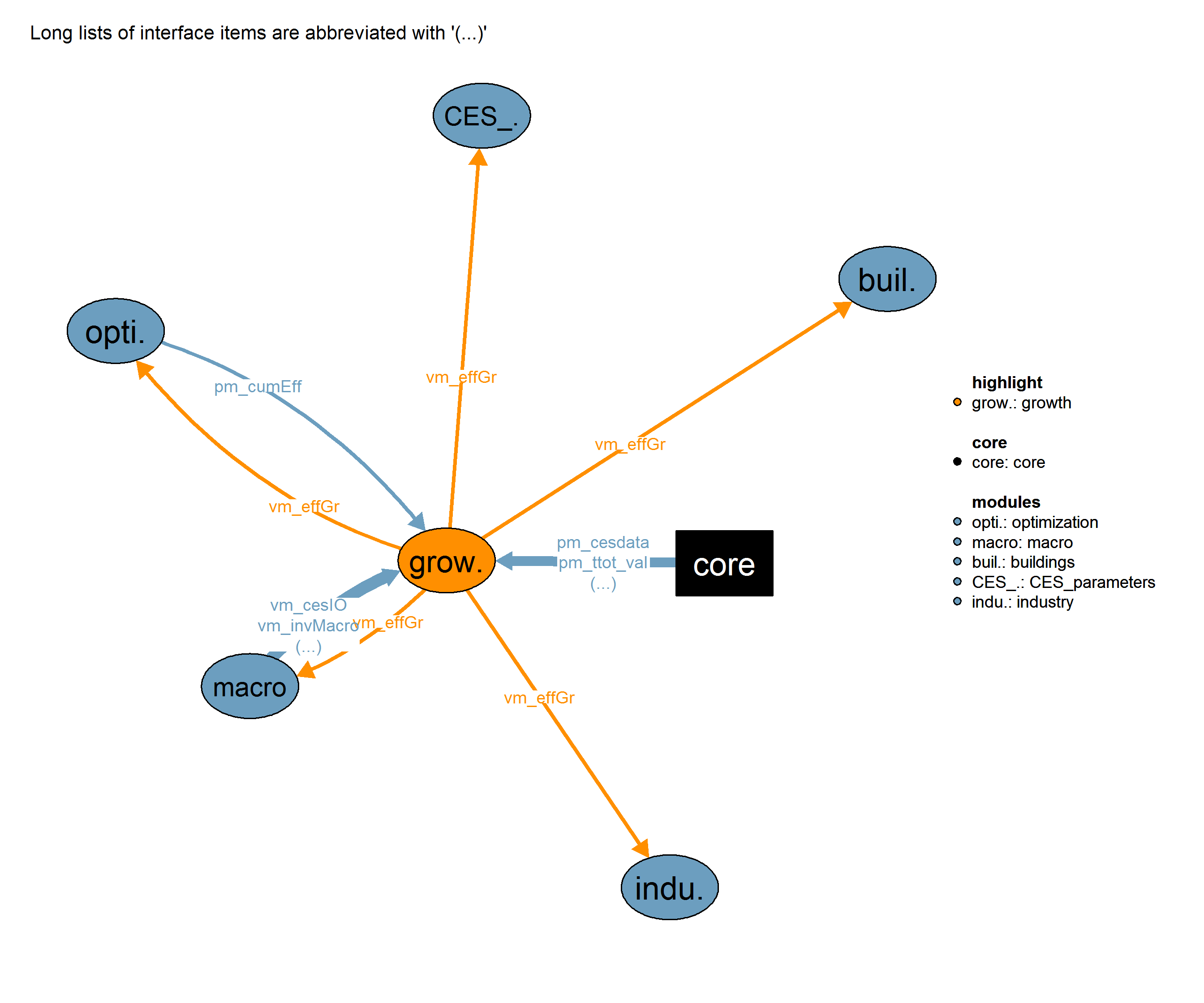Growth (20_growth)
Description
The growth module decides whether to follow a quasi exogenous growth path(calibrated to SSP GDP paths) or an endogenous growth path that includes innovation, immitation and spillover effects
Interfaces

Input
| Description | Unit | A | B | |
|---|---|---|---|---|
| cm_startyear | first optimized modelling time step | \(year\) | x | |
| pm_cesdata (tall, all_regi, all_in, cesParameter) |
parameters of the CES function | x | x | |
| pm_cumEff (tall, all_regi, all_in) |
parameter for spillover externality (aggregated productivity level) | x | ||
| pm_ts (tall) |
(t_n+1 - t_n-1)/2 for a timestep t_n | x | ||
| pm_ttot_val (ttot) |
value of ttot set element | x | ||
| vm_cesIO (tall, all_regi, all_in) |
Production factor | x | ||
| vm_invImi (ttot, all_regi, all_in) |
Investment into imitation | x | x | |
| vm_invInno (ttot, all_regi, all_in) |
Investment into innovation | x | x | |
| vm_invMacro (ttot, all_regi, all_in) |
Investment for capital for ttot | x | ||
| vm_invRD (ttot, all_regi, all_in) |
R&D investments | x |
Output
| Description | Unit | |
|---|---|---|
| vm_effGr (ttot, all_regi, all_in) |
growth of factor efficiency |
Realizations
(A) exogenous
The exogenous growth realization makes no changes to the (macroeconomic) efficiency growth rate parameters. In effect, it leaves all respective parameter specifications to be dealt with by the calibration (usually to given SSP GDP paths) and loading in module 29_CES_parameters, respectively.
Limitations Apart from variation of exogenous GDP scenarios, the model can (in contrast to the endogenous/spillover realization) only slightly correct growth paths in reaction of policy shocks. This correction is done by an adjustment of capital accumulation.
(B) spillover
This realization implies an endogenous growth path. It replaces and overwrites, respectively, the exogenous SSP GDP growth paths. The spillover module computes new efficiency growth parameters for labor and energy that enter the upper level of the CES production function. The implemented growth engine allows to increase growth by R&D investments into innovation and imitation. It also allows for spillover effects that represent the catch-up with technological frontier. The model implemented as well as its parameetrization is based on Huebler et al. (2012).
\[\begin{multline*} vm\_effGr(ttot+1,regi,inRD20) = \left(1 + \left(p20\_coef\_H(ttot,regi) \cdot p20\_coef\_EL(inRD20) \cdot \left(v20\_effInno(ttot,regi,inRD20) + v20\_effImi(ttot,regi,inRD20)\right) \cdot \frac{vm\_invMacro(ttot,regi,"kap")}{\left(vm\_cesIO(ttot+1,regi,"kap")+0.00001\right)}\right)\right)^{\left(\frac{pm\_ts(ttot)}{5}\right) } \cdot vm\_effGr(ttot,regi,inRD20) \end{multline*}\]
\[\begin{multline*} v20\_effInno(ttot,regi,inRD20) = p20\_coeffInno \cdot \left(\frac{vm\_invInno(ttot,regi,inRD20) }{\left(pm\_cesdata(t,regi,inRD20,"eff") \cdot vm\_effGr(ttot,regi,inRD20) + 0.00001\right)}\right)^{p20\_exponInno(ttot,regi,inRD20) }+ p20\_constRD \end{multline*}\]
\[\begin{multline*} v20\_effImi(ttot,regi,inRD20) = p20\_coeffImi \cdot \left(\frac{vm\_invImi(ttot,regi,inRD20)}{\left(pm\_cesdata(t,regi,inRD20,"eff") \cdot vm\_effGr(ttot,regi,inRD20) + 0.00001\right)}\right)^{p20\_exponImi(ttot,regi,inRD20) } \cdot \frac{ \left(\sum_{ regi2}\left(pm\_cesdata(t,regi2,inRD20,"eff") \cdot vm\_effGr(ttot,regi2,inRD20)\right) + pm\_cumEff\left(ttot,regi, inRD20\right)\right)}{ \left(pm\_cesdata(t,regi,inRD20,"eff") \cdot vm\_effGr(ttot,regi,inRD20) + 0.0001\right)} \end{multline*}\]
Limitations This realization was last applied with REMIND version 1.6, but not yet with REMIND2.0. In order to work properly it might be necessary to resolve interference with the calibration and module 29_CES_parameters.
Definitions
Objects
| Description | Unit | A | B | |
|---|---|---|---|---|
| o20_ImiGDP_E | share of imitation RD on GDP | x | ||
| o20_ImiGDP_lab | share of imitation RD on GDP | x | ||
| o20_InnoGDP_E | sahre of Innovation RD on GDP | x | ||
| o20_InnoGDP_lab | share of innovation RD on GDP | x | ||
| p20_coef_EL (all_in) |
coefficient of RD function | x | ||
| p20_coef_H (ttot, all_regi) |
human capital coefficient of RD function | x | ||
| p20_coeffImi | coefficient of Innovation RD investments | x | ||
| p20_coeffInno | coefficient of Innovation RD investments | x | ||
| p20_constRD | RD constant | x | ||
| p20_dataeffscal_avg (ttot, all_regi) |
average efficiency growth across FE types | x | ||
| p20_exponImi (ttot, all_regi, all_in) |
exponent of RD function | x | ||
| p20_exponInno (ttot, all_regi, all_in) |
exponent of RD function | x | ||
| q20_effGr (ttot, all_regi, all_in) |
R&D function | x | ||
| q20_effImi (ttot, all_regi, all_in) |
efficiency improvement by imitation | x | ||
| q20_effInno (ttot, all_regi, all_in) |
efficiency improvement by innovation | x | ||
| v20_effImi (ttot, all_regi, all_in) |
efficiency improvement by imitation | x | ||
| v20_effInno (ttot, all_regi, all_in) |
efficiency improvement by innovation | x |
Sets
| description | |
|---|---|
| all_in | all inputs and outputs of the CES function |
| all_regi | all regions |
| cesParameter | parameters of the CES functions and for calibration |
| in(all_in) | All inputs and outputs of the CES function |
| inRD20(all_in) | Inputs included in extended endogenous growth |
| modules | all the available modules |
| noRD(all_in) | Inputs not included in endogenous growth |
| ppfEn(all_in) | Primary production factors energy |
| regi(all_regi) | all regions used in the solution process |
| t(ttot) | modeling time, usually starting in 2005, but later for fixed delay runs |
| tall | time index |
| ttot(tall) | time index with spin up |
Authors
Marian Leimbach, Lavinia Baumstark
See Also
01_macro, 29_CES_parameters, 36_buildings, 37_industry, 80_optimization, core